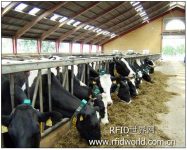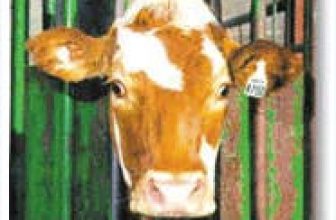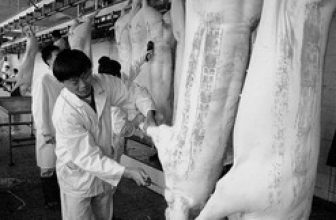
Danish dairy farmers use RFID to increase production and prevent diseases
[ad_1]
The Danish dairy farm uses the RFID real-time location system (RTLS) to help farmers locate individual cows in the herd, analyze the behavior of the cows, and detect disease precursors in time. Early detection and treatment of diseases can increase farm yields and reduce the chance of having to slaughter cows due to diseases.
Farmers also use this technology-based on cow behavior and feeding patterns-to find cows that are entering estrus and are about to ovulate. With timely knowledge of this kind of information, dairy farmers can arrange for insemination of cows, which has a higher conception rate than scheduling insemination according to the calendar cycle. The increase in fertility success rate enables the dairy cows on the farm to continue to give birth to offspring, thereby increasing the profitability of dairy farmers.
This technology was developed by the Danish company SmarterFarming and uses Ubisense active, ultra-wideband RFID tags and readers. The tag transmits a series of shortwave signals (one billionth of a second or less) at a frequency of 6-8 GHz. According to Ubisense, the extremely short-wave characteristics of pulses make them better protected from RF interference from objects and other RF noises compared to the usual RFID RTLS technology. When the reader receives the tag signal through the phased antenna, it uses two complementary techniques-Time Difference of Arrival (TDOA) and Angle of Arrival (AOA)-to calculate the position of the tag,

Several Danish farms are currently using the CowDetect system
Keld Florczak, President of SmarterFarming, developed CowDetect, an animal tracking and monitoring system. When he interviewed Aage Hindhede, the 10th generation heir of a farm in Ringköbing-Skjern, Denmark (130 cows), he realized that dairy farmers wanted to find a way to ensure that each cow was milked every day The number of times can improve the overall management level of the herd.
Hindhede is now also using this technology to observe the occurrence of diseases in 130 dairy cows and 130 calves, and to detect adult cows in estrus. Within a year of using the CowDetect system on the farm, he said that compared with the past when only relying on the naked eye to observe animals, the new system has improved the success rate of insemination of dairy cows and is also more effective in preventing animals from getting serious diseases.
Three other Danish farms also adopted the CowDetect system this year. The largest farm has a total of 600 cows. The farm adopts mechanical and fully automatic milking equipment, and the cows learn to automatically arrive at the milking station several times a day according to a special feed. The RFID reader installed above the mechanical milking equipment reads the passive, ISO-compliant 134.2 kHz RFID tag on each cow’s ear to confirm that the cow has been milked. If the information collected by the reader indicates that a cow has not been fully milked, the farmer needs to find the cow and bring it to the milking equipment. Before adopting RFID systems, farmers might have to spend several hours looking for cows that were not regularly milked. After adopting CowDetect, the farmer can immediately know the location of these cows.
In order to develop the animal behavior analysis component of the CowDetect system, Florczak and Hindhede sought out animal health and behavior experts from the Agricultural Technology and Food Innovation Association. Experts listed 14 indicators, such as the feeding frequency of cows, or the speed and direction of movement-which can be used as the basis for behavioral analysis. For example, at the earliest stage of ketosis (a disease common in adult cattle), dairy cows will show signs such as reduced feeding time. Cows suffering from ketosis may have abnormal gait, be aggressive or growl.

CowDetect label
Early detection of ketemia is very important for dairy farmers, Hindhede said, because if not detected and treated in time, the disease will cause dairy cows to stop producing milk. Once this happens, the cow will no longer produce any benefits, and the farmer will have to slaughter it. Usually dairy farmers observe changes in cow manure and feeding habits before realizing that cows are suffering from ketosis. But Hindhede and Florczak said that using this system to analyze the feeding and movement patterns of each cow can detect diseases a week in advance. Sick cows will stop producing milk within 14 days if they are not treated in time.
Florczak developed a set of arithmetic for various indicators and established an early warning mechanism in the CowDetect software. Farmers can use these alerts to locate and detect specific animal diseases. If the label indicates the arrival of the egg stage of the milk steak, the dairy farmer can plan insemination.
Although the Ubisense tag and software can quickly locate a single cow within 15 cm, Florczak said, it is not enough to accurately perform some measurements, such as a cow’s specific body position or slight movement. For more precise measurements, Florczak combined Ubisense tags with another non-RFID technology (he declined to give details because this technology is still applying for a patent). These two devices and a power supply battery are put in a sturdy jacket and installed under the collar of each cow.
According to Florczak, a farm with 200 cows requires 200 customized Ubisense label modules, and the average cost per cow is US$511. This cost includes all software and hardware, but does not include manual installation costs. This system is currently available in Europe, North America and some parts of Asia.
Using CowDetect to track and detect dairy cows, AgroTech estimates that farmers can save US$448-505 per cow per year, taking into account the reduction in labor costs and the increase in herd productivity.
[ad_2]





